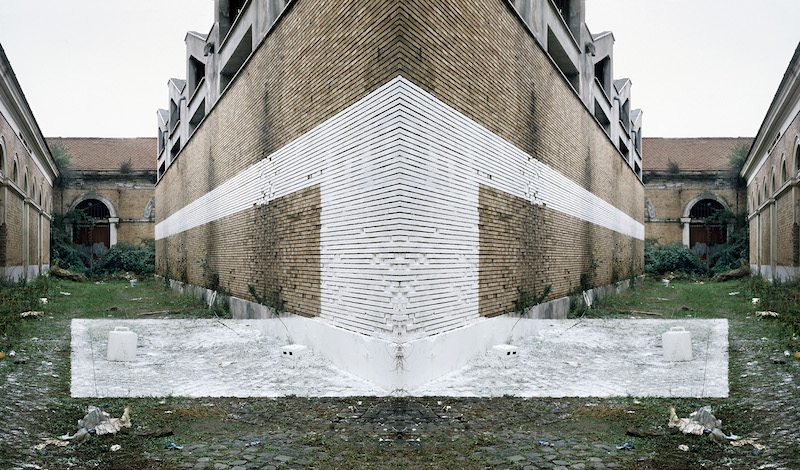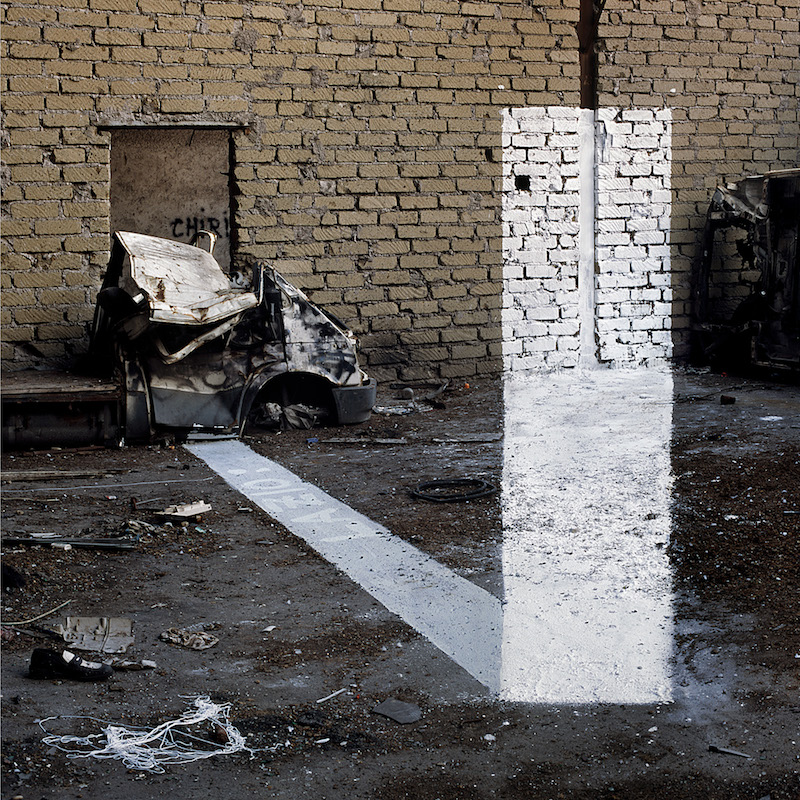
Corner the Mirror by Mimmo Rubino. Photo by Mimmo Rubino.
Some of the most popular viral images of all-time have to be the photos that circulate of 3d chalk art. 3d chalk art is the chalk art drawn on streets which, from one very specific angle, looks like the image is popping off of the ground and into three dimensions. From any other angle, the work looks oddly stretched out and misshapen. The technique is so popular that there are a handful of artists who have become well-known for it. There’s no doubt that the internet has helped these artists, but I don’t really consider them street artists. I just bring them up to give a very well-known example of op art (art that involves optical illusions) on the street. Real street artists are doing op art on the street too though, and I think the internet has probably been even more helpful to them (after all, when you’re doing a legal chalk drawing, you can explain to a crowd exactly what you’re doing, a luxury that most street artists do not have).
Mimmo Rubino aka Rub Kandy paints geometric artworks that can really only be properly seen from one quite particular angle/perspective, often painting in abandoned spaces where few people are likely to visit. It’s only in the last few years and thanks to the internet that someone like Rubino can come along to make this kind of work and reach a large audience without institutional or government support. Looking at it from anywhere else, Rubino’s murals might be quite easy to disregard as random and meaningless paint on the wall or ground. Without photographs, much of Rubino’s work is effectively invisible, but with the internet, those photographs and the otherwise invisible art he documents can be shared with enormous audiences.
Although most street artists don’t like to admit it, Rubino acknowledged to IdN Magazine that some of his street work is “made up to be photographed.” When you begin to understand how Rubino approaches his work, that perspective (and his honesty about it) makes sense. In the same interview, he explained his thoughts on the web and street art:
About evolution… There’s another important issue: the development of Web. Street art, after all, is not such news. The news is, instead, what we’ve seen in the last ten years: the development of Web.
Thanks to social networks, Internet sites and journalism culture spreads all over. There were fanzines before, but Internet is a hundred times stronger and this is influencing the art works. A weird mutation is happening in street art and in Public Art in general. Works are often projected to be photographed and posted on the Web, you can see a new form of street art in which photography or video are fundamental. Nowadays often the street art piece of work lives just in the pictures and Web pages that show it.
I don’t know if you can still call it street art but that’s what is happening to it. The circle of leaves that Spy created in the centre of a concrete pitch is doomed to be deleted by the wind and will live just in the picture. Pictures and Web take away charm from some pieces of work, but they make it possible to create other kinds of works, more ephemeral and conceptual ones or works like my anamorphosis that you have to look only from some angles. In fact we see a heavy return to optical illusion. My series of anamorphosis, for example, couldn’t exist without photography, it is most of all photography, you can prove intervention that would disappear in few days and work where nobody ever enter. Thanks to the Web I can show them to you in Honk Kong and don’t give a damn about old curators living round the corner of my house. The world changes, the artist has to be a mutant.
After reading that interview, I asked Rubino if he made works specifically to be seen online. His response is insightful:
Most people interested in art, when it’s not possible to visit the works in person, find information on the internet, so it’s normal to think that artists work also planning to spread their artwork on the internet. This does not mean that artists prefer for people to see their works on the internet instead of the street, but only that artists are aware of the increased visibility for their work on the internet.
Rubino isn’t doing anything that would have been impossible 20 years ago. The difference is that 20 years ago nobody could have cared or really seen their work compared to today, except in a very limited art-world setting like what Felice Varini has done. The internet has opened up the door for illegal op art on the street, allowing artists to display their work online in the way that it is intended, rather than letting it sit on the street ignored because the vast majority of the potential audience for the work doesn’t happen to stand at the perfect spot to see it.

CHiRi by Mimmo Rubino. Photo by Mimmo Rubino.